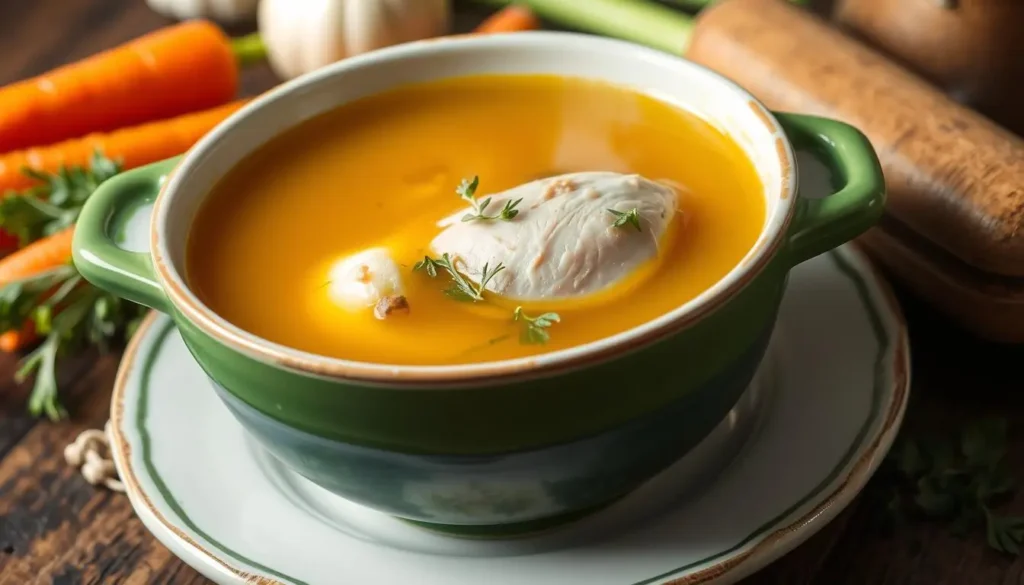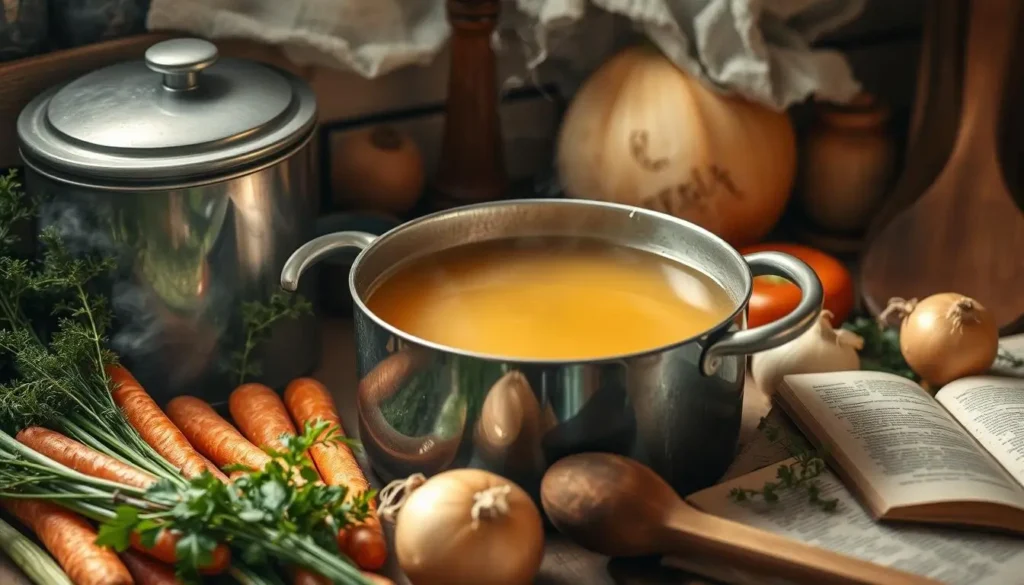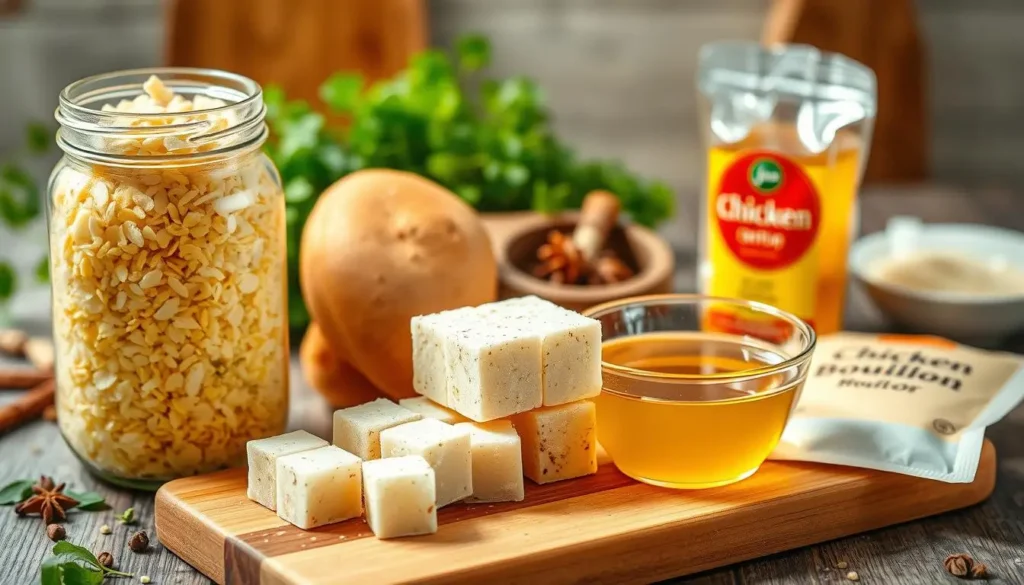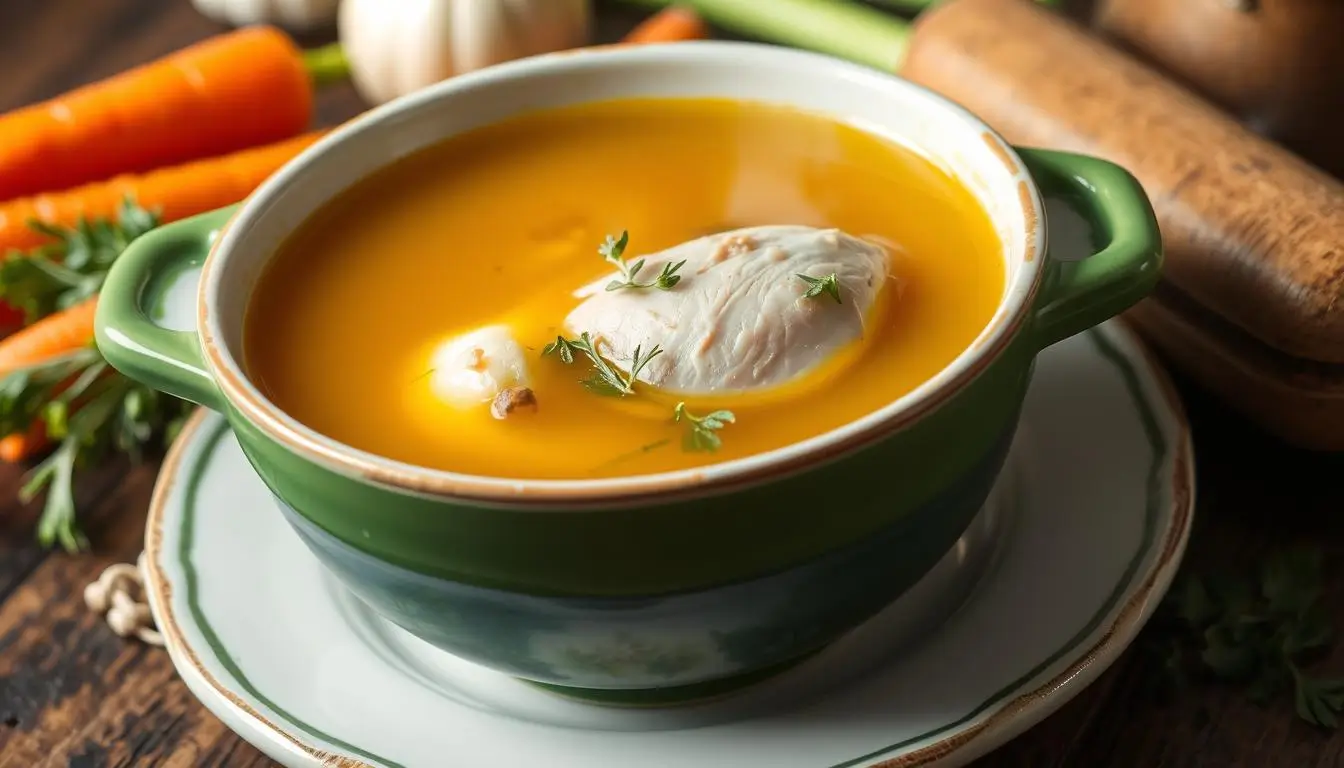Chicken bouillon is a versatile and powerful flavor enhancer. It’s a staple in many kitchens. It adds depth and richness to various dishes, making it a favorite among cooks.
It’s great for soups, stews, and sauces. Chicken bouillon is essential in many recipes.
Using chicken bouillon can greatly improve your meals’ taste and quality. It’s perfect for adding flavor to your favorite recipes or creating new ones.

Chicken bouillon is excellent in many cuisines. It enhances the natural flavors of ingredients, creating a more complex taste. With it, you can make delicious meals that impress everyone.
Key Takeaways
- Chicken bouillon is a versatile flavor enhancer that can be used in a variety of dishes.
- It adds depth and richness to soups, stews, and sauces.
- Chicken bouillon is a valuable cooking ingredient for home cooks and professional chefs.
- It can be used to create new recipes or enhance the flavor of existing ones.
- Chicken bouillon is a powerful flavor-boosting ingredient that can elevate the taste of your meals.
- It is a staple in many kitchens due to its ability to enhance the natural flavors of ingredients.
Table of Contents
What Is Chicken Bouillon and Its Culinary Heritage
Chicken bouillon has a long bouillon history that goes back centuries. It started in ancient times. Many culinary traditions worldwide have used flavored broths, each with their own twist.
Chicken bouillon is key in many global cuisines. Its umami flavor makes dishes richer and more flavorful. It’s found in Asian soups and European stews, shaping flavors across cultures.
Historical Origins of Bouillon
The first bouillon-like dishes were in ancient China. They used a flavored broth for soups and stews. In Europe, medieval cooks made clear broths with meat and veggies, creating nourishing dishes.

Traditional Uses in Global Cuisines
Chicken bouillon is used in soups, stews, and sauces. Its umami flavor is especially valued in Asian cooking. It adds depth to dishes like wonton soup and pho.
The Science Behind Flavor Enhancement
The science behind chicken bouillon’s flavor boost is interesting. It’s because of glutamates, amino acids found in foods. Using bouillon, cooks can make dishes with a rich umami flavor. This adds depth and complexity to many dishes.
Different Forms of Chicken Bouillon Available Today
Chicken bouillon comes in many forms, each with its own benefits. You can find it as bouillon cubes, powder, liquid concentrate, or paste. Knowing the differences helps you pick the best one for your recipes.
Here are some key characteristics of each form:
- Bouillon cubes: convenient and easy to use, but may contain higher amounts of sodium
- Powder: versatile and can be used to make a variety of dishes, from soups to sauces
- Liquid concentrate: rich and flavorful, but may require refrigeration after opening
- Paste: intense flavor and can be used to make small amounts of bouillon, but may be more expensive
Think about your recipe and the flavor you want when choosing chicken bouillon. For example, liquid concentrate is perfect for soups and stews. Powder is better for sauces and gravies. Bouillon cubes are great for quick meals, and paste adds a deep flavor to dishes.

In summary, the right chicken bouillon form depends on your cooking style and recipe. By understanding each form’s characteristics, you can choose wisely and make delicious meals with the perfect flavor.
| Form | Advantages | Best Uses |
|---|---|---|
| Bouillon Cubes | Convenient, easy to use | Soups, stews, quick meals |
| Powder | Versatile, can be used to make a variety of dishes | Sauces, gravies, soups |
| Liquid Concentrate | Rich and flavorful, can be used to make small amounts of bouillon | Soups, stews, sauces |
| Paste | Intense flavor, can be used to make small amounts of bouillon | Sauces, gravies, marinades |
Understanding Chicken Bouillon Ingredients
Chicken bouillon’s ingredients are key to its flavor and nutrition. Different brands have different mixes, but common ones include natural flavors, spices, and preservatives. Knowing what’s in your bouillon helps you make better choices.
Chicken bouillon often has salt, MSG, yeast extracts, and dried veggies. These mix to make a savory taste that boosts dish flavors. Natural flavors like chicken stock and spices aim for a real taste. Always check for fewer artificial ingredients and preservatives.
Here are some key points to consider when evaluating bouillon ingredients:
- Natural flavors: Look for products with natural flavors, such as chicken stock, vegetables, and spices.
- Preservatives: Choose products with minimal added preservatives, such as MSG and artificial flavorings.
- Nutritional information: Check the label for nutritional information, including sodium content, calories, and serving size.
Knowing what’s in your bouillon lets you pick better options. Whether you want something low in sodium or full of natural flavors, being informed helps you cook healthy, tasty meals.
| Ingredient | Role | Nutritional Value |
|---|---|---|
| Salt | Flavor enhancer | High sodium content |
| MSG | Flavor enhancer | Artificial preservative |
| Yeast extracts | Flavor enhancer | Rich in umami flavor |
| Dehydrated vegetables | Flavor and texture | Rich in fiber and nutrients |
The Art of Cooking with Chicken Bouillon
Cooking with chicken bouillon is an art that needs practice. It’s about flavor enhancement and using the right cooking techniques. This can make your dishes taste amazing, whether it’s a simple soup or a complex sauce.
Remember, recipe adaptation is key when using chicken bouillon. It can make bland dishes taste better or enhance leftovers. For instance, adding bouillon to simmering veggies can give them a flavor boost. You can also use it as a base for soups, stews, or as a seasoning for meats and sauces.
Here are some tips for cooking with chicken bouillon:
- Start with a small amount and adjust to taste, as bouillon can be quite strong
- Use bouillon to add depth and richness to your dishes, rather than just saltiness
- Experiment with different cooking techniques, such as reducing or concentrating the bouillon to intensify the flavor
By following these tips and practicing your cooking techniques, you can master cooking with chicken bouillon. This will take your dishes to the next level. With a bit of flavor enhancement and recipe adaptation, you’ll create meals that impress everyone.
| Cooking Technique | Flavor Enhancement | Recipe Adaptation |
|---|---|---|
| Reduction | Concentrated flavor | Sauces and marinades |
| Infusion | Delicate flavor | Teas and soups |
Creative Ways to Use Chicken Bouillon in Recipes
Chicken bouillon is a versatile ingredient that can add a flavor boost to many dishes. It’s great in soups, stews, rice, and grain dishes. Using bouillon recipes can make your cooking even better.
Soups and Stews
Chicken bouillon is often used in soups and stews. It’s perfect as a base for chicken noodle soup or to add flavor to beef stew. Here are some other ideas:
- Chicken and rice soup
- Vegetable stew
- Chicken and dumplings
Rice and Grain Dishes
Chicken bouillon can also flavor rice and grain dishes. It’s great for cooking rice, quinoa, or other grains. Try it in chicken and rice bowls or stir-fries.
Sauce and Gravy Enhancement
Chicken bouillon can also enhance sauces and gravies. Use it to make homemade chicken gravy or add to store-bought sauces for more flavor.
Adding chicken bouillon to your cooking can boost flavors in many dishes. Try it in soups, stews, rice, grain dishes, or sauces. It’s a versatile ingredient that can elevate your cooking.
| Dish | Ingredients | Instructions |
|---|---|---|
| Chicken and Rice Soup | Chicken bouillon, rice, chicken, vegetables | Combine ingredients in a pot and simmer until the rice is cooked |
| Chicken and Dumplings | Chicken bouillon, chicken, dumpling mix | Combine chicken bouillon and chicken in a pot, then add dumpling mix and cook until the dumplings are done |
Making Homemade Chicken Bouillon
Making your own bouillon lets you flavor customize and choose your ingredients. First, you need chicken bones, veggies, and spices. Then, simmer them in water to get the flavors out.
Homemade bouillon is great because you can make it taste just how you like. Use carrots, celery, and onions to make a rich stock. This stock is perfect for soups and sauces.
- Chicken bones: providing the base flavor for the bouillon
- Vegetables: adding depth and complexity to the stock
- Aromatics: enhancing the flavor profile with herbs and spices
After making the stock, you can freeze or dehydrate it. This way, you can enjoy your bouillon all year. It saves time and ensures you always have quality bouillon.
By making your own stock, you get to control the flavors and ingredients. This homemade stock is great for many tasty dishes. It’s a must-have in any kitchen.
Storage Tips and Shelf Life Considerations
Keeping chicken bouillon fresh is key. The right bouillon storage methods are important. For powdered bouillon, use airtight containers. Liquid bouillon needs to be refrigerated to stop bacteria.
Organizing your pantry helps keep bouillon fresh. Here are some tips for storing bouillon:
- Store powdered bouillon in a cool, dry place
- Refrigerate opened liquid concentrates and use within a few days
- Freeze bouillon for longer storage
Remember, food safety is crucial. Always check expiration dates and watch for spoilage signs. Following these tips will help you enjoy your chicken bouillon longer and keep it safe.
| Storage Method | Shelf Life |
|---|---|
| Airtight container | 6-12 months |
| Refrigeration | 3-5 days |
| Freezing | 6-12 months |
Common Mistakes When Using Chicken Bouillon
Using chicken bouillon can lead to mistakes that mess up your dish’s flavor. One big error is adding too much bouillon. This makes your dish too salty. Start with a small amount and add more if needed.
Another mistake is not considering bouillon’s strong flavor. This can make your dish hard to fix. It’s important to remember this when cooking.
Here are some tips to avoid these mistakes:
- Use the right amount: Too little bouillon makes your dish taste bland. Too much makes it too salty.
- Adjust for saltiness control: If your bouillon is high in sodium, adjust your recipe to balance it out.
- Taste as you go: This helps you catch and fix any flavor mistakes before they ruin your dish.
By following these tips, you can make delicious dishes with chicken bouillon.
Remember, making mistakes is part of learning. Don’t worry if things don’t turn out right at first. With practice, you’ll get better at using chicken bouillon. Your dishes will taste great, with just the right amount of flavor.
Health Considerations and Dietary Restrictions
Using chicken bouillon can have health implications and dietary restrictions to consider. Many bouillon products are high in sodium, which is bad for those with high blood pressure. Choosing low-sodium bouillon can help lower sodium intake while keeping flavor.
For those with dietary restrictions, there are good alternatives. Gluten-free or vegetarian bouillon is a great choice. Also, organic and non-GMO bouillon products are now available, catering to those who want cleaner food.
Sodium Content Awareness
It’s important to know the sodium content, especially for those with dietary needs. Reading labels and understanding ingredients helps make better choices. Some brands offer low-sodium bouillon, making it easier to eat healthy.
Allergen Information
Common allergens in bouillon include gluten, soy, and MSG. But, many brands now offer allergen-free options. Always check the label to ensure it meets your dietary needs.
Alternative Options
For those with dietary restrictions, there are many alternatives. Vegetarian and vegan bouillon products are popular, offering a plant-based choice. These products are just as tasty and versatile, making them a great option for those with dietary needs.
By considering health and dietary restrictions, you can enjoy chicken bouillon while staying healthy. Whether you choose low-sodium, allergen-free, or alternative products, there’s something for everyone.
| Product Type | Sodium Content | Allergen Information |
|---|---|---|
| Low-Sodium Bouillon | Less than 200mg per serving | Gluten-free, soy-free |
| Vegetarian Bouillon | Varies by brand | MSG-free, vegan-friendly |
| Organic Bouillon | Less than 400mg per serving | Non-GMO, gluten-free |
Professional Chefs’ Tips for Using Chicken Bouillon
To improve your cooking, learn from professional chefs. They have years of experience. Their advice can make your dishes better. Using chicken bouillon well means adding it to other ingredients for a deep flavor.
Renowned chefs say the key is balance. Mix chicken bouillon with herbs and spices for a memorable dish. Here are some tips for getting it right:
- Choose the best ingredients for flavor.
- Try different amounts of bouillon and other ingredients.
- Let the flavors mix slowly for the best taste.
Using these tips, you can become a better cook. Chicken bouillon is a great ingredient to start with. It’s versatile and adds a lot of flavor to your dishes. This will help you master the art of layering flavors and improve your cooking.
Conclusion: Mastering the Magic of Chicken Bouillon in Your Kitchen
Chicken bouillon is a powerful ingredient in cooking. It can make simple dishes taste amazing. Chefs and home cooks love it for boosting flavors.
Now, you know how to use chicken bouillon in your cooking. It’s great for soups, stews, and sauces. It adds depth and richness to any dish.
Start experimenting with chicken bouillon in your kitchen. It’s a secret to making food more delicious. Share your recipes and inspire others to try it out.
FAQ
What is chicken bouillon and how is it used in cooking?
Chicken bouillon is a concentrated broth made from chicken, herbs, and spices. It’s used to flavor soups, stews, sauces, and more. It adds a rich, savory taste to dishes.
What are the different forms of chicken bouillon available?
You can find chicken bouillon in cubes, powder, liquid concentrate, and paste. Cubes and powders are easy to use for quick flavor. Concentrates and pastes offer more control over seasoning.
What are the key ingredients in chicken bouillon?
Chicken bouillon includes chicken, salt, MSG, yeast extract, and dehydrated veggies like onions and carrots. Some products also have natural or artificial flavors and preservatives.
How do I properly store and use chicken bouillon?
Store chicken bouillon in an airtight container in a cool, dry place. Cubes and powders last 1-2 years unopened. Opened containers should be used in 6-12 months. Start with a small amount and adjust to taste, as it’s high in sodium.
Are there any health considerations when using chicken bouillon?
Chicken bouillon is high in sodium, so it’s best to use it sparingly if you’re on a low-sodium diet. It may also contain MSG, which some people avoid. Always check the label for dietary restrictions or allergies.
Can I make my own homemade chicken bouillon?
Yes, you can make homemade chicken bouillon by simmering chicken bones, meat, and veggies. This way, you can control the ingredients and flavor. You can freeze or dehydrate it for later use.
What are some common mistakes to avoid when cooking with chicken bouillon?
Avoid using too much bouillon to prevent an overly salty dish. Also, adjust recipes properly when substituting bouillon for broth or stock. Start with a small amount and taste as you go to get the right flavor.
- Visit our Instagram page

